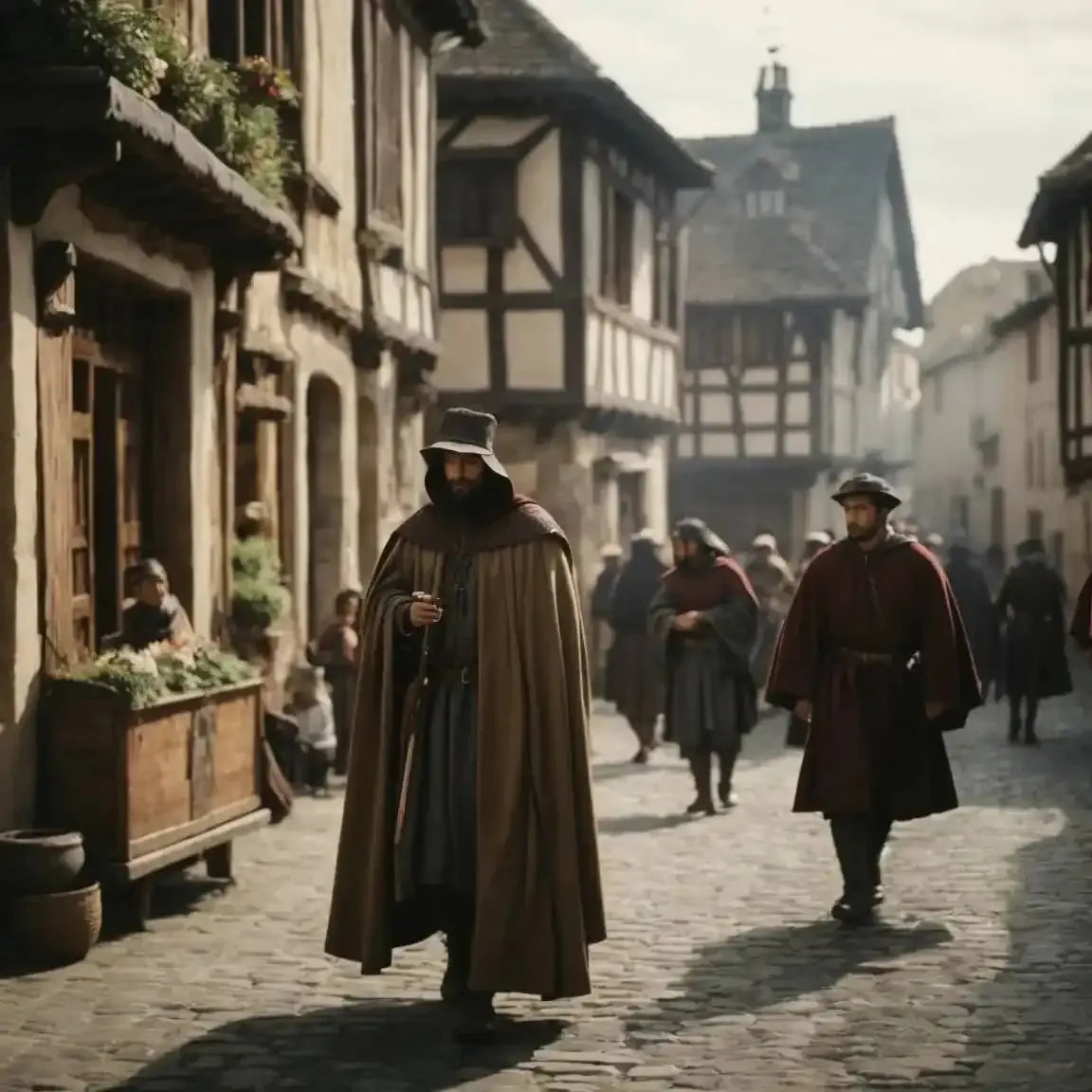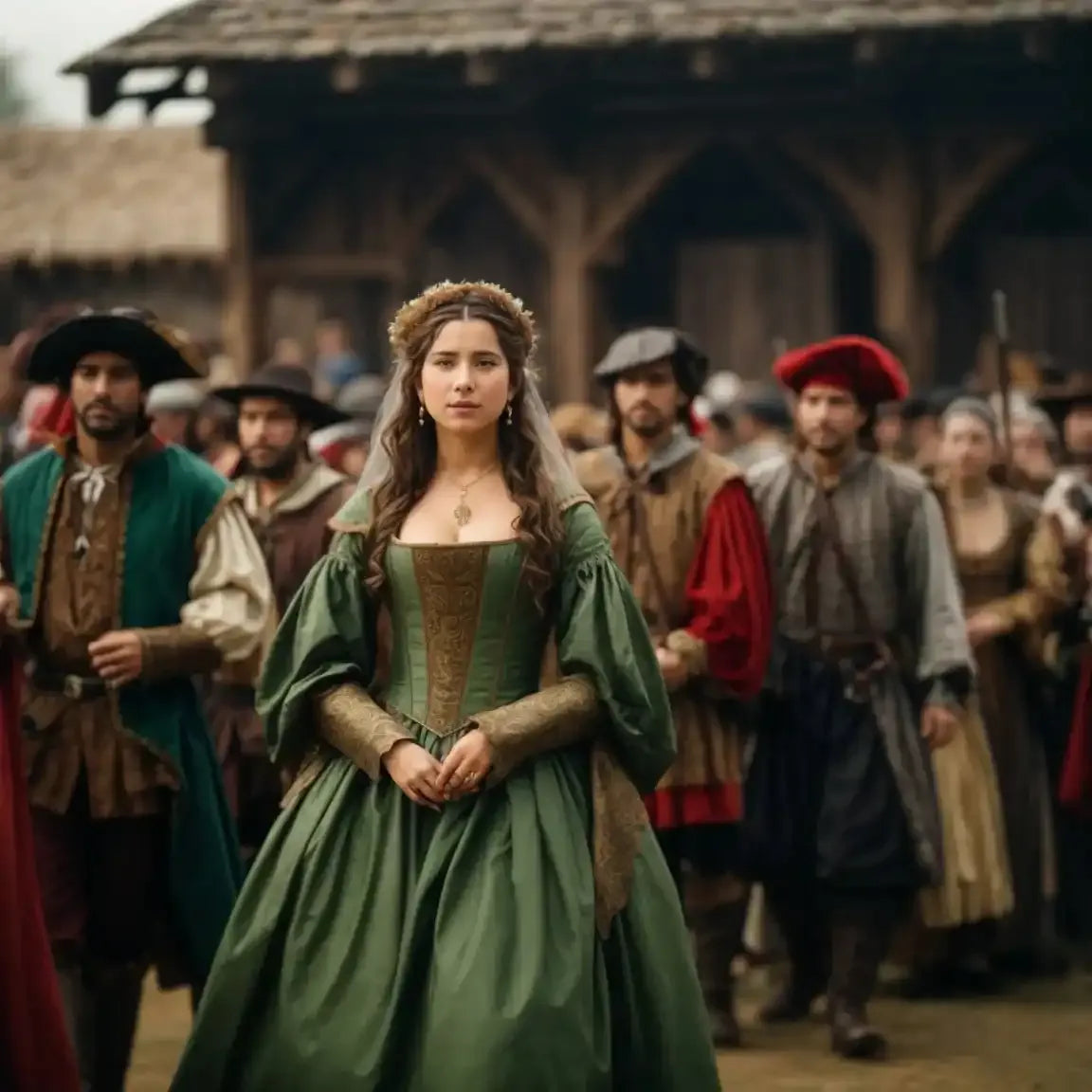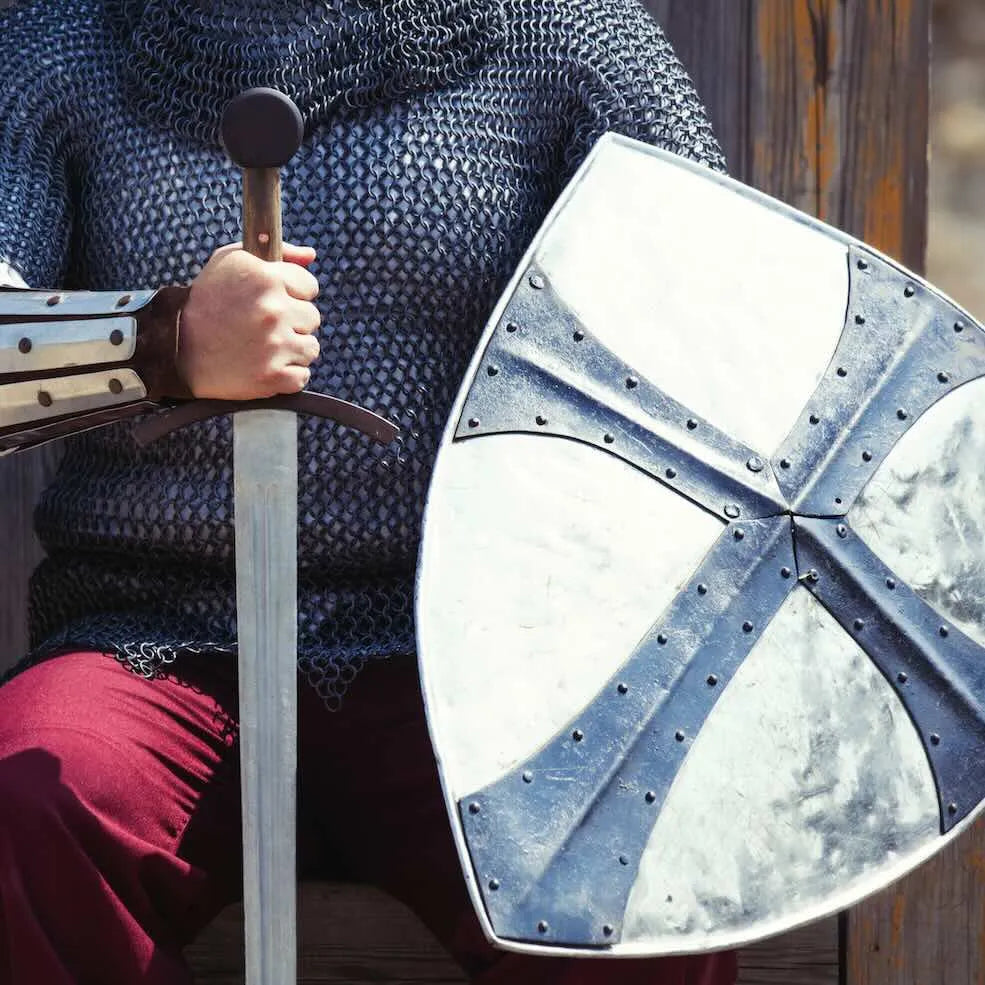
Creating Authentic Medieval Costumes
Reviving the grandeur of the Middle Ages, enthusiasts at themed events and reenactments yearn for the allure of historically accurate Medieval Costumes. Achieving this authenticity is a craft that merges diligent historical research with contemporary practicality. The quest for creating ensembles that mirror medieval styles yet cater to modern tastes is a complex art, blending tradition with a modern appeal. This challenge is taken by both seasoned reenactors seeking to deepen their immersion and hobbyists looking to make a grand entry into the world of historical reenactments and themed gatherings. Here we delve into the art of recreating Medieval costumes that strike a perfect harmony between the authenticity of yesteryears and the accessibility of today.
Key Takeaways
- Historical accuracy serves as the cornerstone in the creation of engaging Medieval Costumes.
- Themed events and reenactments are perfect arenas for showcasing meticulously crafted period attire.
- Finding a balance between traditional styles and modern convenience is key to contemporary costume creation.
- Adaptability and creative use of modern materials can lead to impressive, historically resonant ensembles.
- Simplicity in design does not detract from the overall impact of a costume at casual or first-time reenactment experiences.
- Accessibility of resources enhances inclusivity, inviting a wider audience to explore and partake in medieval-themed events.
Understanding Medieval Fashion Basics
Delving into the rich tapestry of Medieval fashion, one finds a world where the fabrics and textures speak as much of status and function as they do of style and aesthetics. The distinctive features of period costumes not just conveyed a sense of identity but also heralded the textile craftsmanship of the time.
The Role of Fabrics and Textures
Fabric choices were anything but accidental in medieval sartorial practices. Luxurious velvets and sturdy wools played a pivotal role in the crafting of attire that could withstand the rigors of feudal life while affording nobility an opulent display. Textures varied significantly, from the coarse weaves worn by peasants to the refined fabrics adorning the aristocracy. Such distinction in medieval clothing textures was not merely a matter of preference but a deliberate delineation of social hierarchy.
Color Palettes and Dyeing Techniques
Authenticity in replicating medieval clothing is significantly influenced by the hues employed. Rich color palettes emerged from skilled dyeing techniques, often compounded from local resources or costly imports, which rendered vibrant blues, profound reds, and majestic purples. Shades that graced courtly attire often owe their intensity to the labor-intensive processes involved, making the vivid coloration not just a matter of aesthetic but a clear indicator of wealth.
Distinctive Features of Medieval Dress
Each stitch and embellishment served a larger narrative in medieval garments. Ornate trimmings, such as fur collars crafted from repurposed modern fabric, showcased an attention to simulation that enhanced the illusion of stepping out of history's pages. While the medieval clothing ranged broadly in style, common threads weaved through the era were the long, flowing lines and the belted waists which appeared in numerous period costuming, adding grace and stature to the wearer.
- High-waisted gowns were prized for their flattering silhouette and authoritative presence.
- Embellishments like faux fur and metal fastenings added richness and texture to a costume’s appearance.
- Resourcefulness in material sourcing was key, with historical reenactors often turning to vintage or repurposed fabrics to achieve the correct visual effect.
The pursuit of medieval fashion authenticity extends beyond the garments themselves and into the very fibers and dyes that composed them, revealing a complex heritage of artisanship and social stratification that continues to captivate enthusiasts of period costumes today.
Constructing the Foundation: Undergarments and Their Importance
When it comes to donning historical costumes, the correct layering of undergarments is primordial in ensuring both accuracy and comfort. The adherents of medieval attire recognize that the very essence of authentic representation begins with what isn't immediately visible to the onlooker—the foundational garments known collectively as undergarments. Below, we explore the essential components that constitute the base to any credible medieval ensemble.
The Linen Shift: First Layer Close to the Body
Akin to a second skin, the linen shift constituted the first layer of medieval dressing, sitting close and personal to the body. Esteemed for its breathable quality, linen was the go-to material, providing both comfort and a necessary barrier between the body and additional clothing layers. It offered modesty and, importantly, a realistic resemblance to historical fidelity for those aiming to recreate the medieval experience. The shift's design catered to the hygiene and ease of wear during long periods, a small detail with a significant impact on the wearer's experience.
Medieval Hosiery: Wool Socks and Footwear
At the feet of medieval life, medieval hosiery comprised mainly woolen socks and durable leather shoes, anchoring the ensemble's realism from the ground up. Functionality ruled the choice in hosiery, keeping feet warm in the cold months and serving as a cushion within the firm leather of period-appropriate footwear. Reenactors and costumers aiming for verisimilitude place a premium on these often-overlooked components, as they complete the transformation, ensuring a portrayal that resonates with historical accuracy.
Crafting High-Waisted Gowns without the Fuss
The allure of medieval fashion need not be a distant dream for those with limited sewing expertise. With a few clever tricks and the right materials, creating a Medieval dress becomes a manageable project. Embracing the spirit of resourcefulness that characterizes the modern approach to reviving historical costumes, we explore how everyday items can be transformed into stunning high-waisted gowns.
Converting Everyday Items into Authentic-Looking Pieces
Unearthing the potential of items like vintage velvet curtains and repurposed bodices, the construction of a Medieval dress for LARP events or a themed gathering becomes an accessible venture. Starting with a simple boned bodice from brands such as Topshop's Wit and Wisdom line, one can create the base for an elegant high-waisted gown. Offering a sense of historical context, these modern pieces are versatile foundations for the medieval ensemble.
Adapting Modern Bodices for Historical Accuracy
Adapting a contemporary bodice entails elevating it to the characteristic high-waisted style seen in medieval gowns. This can be achieved by pairing it with fabrics that echo the textures of the past, such as velvet or wool. Assembling the skirt portion requires no advanced tailoring when utilizing curtains — the natural hem and width suffice to create flowing and authentic-looking gowns.
Accessorizing with Simplicity: Fake Fur Collars and Cuffs
Enriching the ensemble with accessories is the final touch in constructing a medieval outfit. Simple yet effective, fake fur collars and cuffs can be created from pieces of a faux fur jacket or a modern scarf, circumventing the need for intricate sewing skills. This straightforward addition elevates the Medieval fashion aspect, imbuing a costume with the regal essence of historical accuracy.
- Fabrics such as velvets and wools ensure a period-accurate appearance
- Modern bodices can be tweaked to replicate the medieval silhouette
- Cost-effective and simple sewing alternatives such as curtain drapes or velvet cushions can be utilized for skirts and gowns
- Accessorizing with repurposed items like fake fur adds texture and depth to the overall look
Incorporating Over Garments and Layering Techniques
The embodiment of nobility and intricacy in Medieval-themed costumes is often achieved through the strategic use of over garments and adept layering techniques. These elements are not merely aesthetic enhancements but are pivotal in achieving historical accuracy and creating the depth that distinguishes period attire. Let's consider how the addition of over garments can transform a simple chemise into a fairy tale ensemble, evoking the romance of medieval fashion.
Key to mastering medieval layering is the open-fronted over gown, typically worn over a chemise or an under gown. The construction of these over garments can be a testament to resourcefulness. Utilizing household items such as curtains — plentiful in fabric and often already hemmed — can provide ample material for crafting these pieces without excessive outlay or effort. Even less fabric is required when creating contrasting panels or accents, which can easily be fashioned from a second pair of curtains or a matching cushion cover.
| Garment Type | Base Fabric | Panel/Accent Fabric | Layering Function |
|---|---|---|---|
| Open-Fronted Over Gown | Wide Curtains | Contrasting Curtains or Cushion Cover | Weather Adjustment / Silhouette |
| Chemise Base | Linen or Vintage Sheet | N/A | Hygiene / Comfort |
| Fanciful Sleeves | Velvet Curtains | Ribbon or Trim Accents | Aesthetic Embellishment |
| Period Capes and Cloaks | Heavy Wool Curtains | Faux Fur Trimming | Warmth / Status Symbol |
The prowess of layering extends beyond the pragmatic, embracing the ability to alter one's appearance in response to climate or setting. Moreover, the adaptability provided by layering brings a costume to life, offering a tangible reflection of the sumptuous and versatile wardrobes of medieval nobility. Undoubtedly, the clever integration of different textures and fabrics lends not only visual interest but an element of verisimilitude to the portrayal of medieval roles.
Ultimately, the art of infusing medieval garments with layers is not just an act of creative expression; it reflects the commitment to an authentic reenactment experience. The result is a rich tapestry that mirrors the fashion of a bygone era, inviting onlookers to journey back in time and witness the storied past through the lens of an enthusiast's passionate reimagining.
Medieval-Themed Costumes for Various Occasions
Dressing up for historical play or themed celebrations doesn't have to be a time-consuming affair. Medieval-themed costumes provide an exquisite bridge to the past, and luckily, quick solutions exist for those seeking a plunge into the realms of LARP or first-time reenactments.
Quick and Easy Solutions for One-Off Events
When the calendar marks the date for a one-off medieval fair or themed party, creating an impromptu costume becomes a priority. The key lies in simplicity and clever use of readily available materials. Here is a guide to assembling your medieval attire with minimal fuss:
- Start with a basic boned bodice – easily sourced from fashion retailers like Topshop’s Wit and Wisdom.
- Look for curtains with a rich texture, such as velvet or brocade, which demand no hemming and can be swiftly transformed into a gown.
- Adorn your ensemble with a fur collar, which can be cut from a faux fur jacket or scarf, adding a luxurious touch sans sewing.
- Lace-up backs can be fashioned from ribbon or cord, lending your costume both adjustability and style.
Adaptable Attire for LARP and First-Time Reenactments
For those venturing into live-action role-playing (LARP) or stepping onto the field of a reenactment for the first time, adaptability is key in costume selection. Enhanced by elements that can interchange or be reused, adaptable attire ensures that your garment fits a variety of roles and settings:
- Transforming tie-on sleeves from an old blouse can result in versatile looks that adapt to different characters.
- A lace-up front on a simple dress allows for adjustments in fit, making it suitable for a range of body types.
- An open-fronted robe or surcoat, with minimal sewing from repurposed curtains, offers flexibility for layering over other garments.
An imaginative approach to assembling medieval-themed costumes can lead to strikingly authentic results. By working with resources like Topshop's fashion pieces and vintage household fabrics, enthusiasts can effortlessly step into the past and create a look that is both historically inspired and uniquely their own.
Making Medieval Costumes Accessible: No-Sew Options
The art of crafting medieval clothing need not be an exclusive domain of skilled tailors and seamstresses. With no-sew options increasingly available, historical costumes are becoming more accessible to enthusiasts of all backgrounds. These methods not only simplify the costume-making process but also open the door for more individuals to experience the joy of donning medieval attire at events and reenactments.
Utilizing Fabrics with Pre-Finished Edges
For the aspiring historic enthusiast, finding materials that require minimal handling is a boon. Fabrics with pre-finished edges, such as vintage curtains and drapes, offer a solution to the labor-intensive process of hemming and finishing. By capitalizing on the existing finishes of these materials, one can create majestic looks reminiscent of medieval times — a testament to the affordability and efficiency of no-sew historical costumes.
Exploring the Simplicity of Pull-On Designs
Pull-on designs are another cornerstone of the no-sew approach. These designs allow for the creation of stunning period pieces that emphasize ease of wear. A chemise, for instance, can start with a snugly gathered neckline and elongated sleeves that make use of pre-existing hems. This eliminates the need for detailed stitching while preserving the characteristic flowing silhouette of medieval historical costumes.
Similarly, a no-sew gown can come to life by utilizing a fashion bodice with built-in boning, to which a full pre-hemmed curtain can be attached, creating the skirt. This creative repurposing produces a complex-looking outfit that requires none of the complex stitching typically associated with traditional medieval dressmaking.
| No-Sew Medieval Garment | Fabric Choices | Features | Benefit |
|---|---|---|---|
| Chemise | Linen Sheet | Gathered Neckline, Extra-Long Sleeves | Minimizes Sewing |
| Gown with Boned Bodice | Velvet Curtain | Attached Pre-Hemmed Skirt | Ease of Assembly |
| Surcoat | Brocade Curtain | Finished Edges, Open Sides | Quick Construction |
| Sleeves (Tie-On) | Vintage Fabric with Hem | Attaches via Ties | Flexible Sizing |
This approach bridges the gap between elaborate medieval clothing and modern convenience, creating no-sew options that respect historical aesthetic while being achievable and satisfying. Engaging in the world of pre-finished fabrics lets anyone with an eye for the past bring their medieval fantasies to life, sewing skills or not.
Designing Medieval Reenactment Attire with Accuracy
For the modern-day medieval enthusiast, the recreation of medieval reenactment attire is not simply about dressing up; it is an act of cultural immersion and historical fidelity. Experts and novices alike delve into the nuances of medieval fashion, using a blend of research, textiles, and technique to achieve historical accuracy in their period costumes. Key to this authenticity is the faithful replication of garments depicted in works like those by Rogier van der Weyden, as well as incorporating insights from historical experts.
One must be astute in the use of materials and construction: the selection of fabrics and closures, alignment with the era’s layering practices, and perhaps most importantly, ensuring wearers can move comfortably, particularly when garments are to be worn over armor. Each choice must resonate with the time period, from the supple linen shifts that afforded protection and comfort, to the splendor of a wool houppelande, often lined with silk, which graced the backs of the nobility.
Furthermore, practical details such as the fastening mechanisms play a crucial role. Taking cues from historical finds, the use of bronze clasps and other period-accurate closures can make or break the illusion of stepping straight from the pages of history. Attention to the subtleties of functionality ensures that the wearers can engage in the event’s activities while maintaining the appearance of a meticulously crafted, era-appropriate ensemble.
| Garment | Historical Details | Modern Adaptations | Primary Function |
|---|---|---|---|
| Linen Shifts | Breathable, Close-fitting | Repurposed Linen Fabrics | Comfort & Modesty |
| Wool Houppelande | Silk-lined, Wide Sleeves | High-Quality Wool Substitutes | Nobility Representation |
| Bronze Clasps | Historical Finds Replication | Functional & Aesthetic Clasps | Garment Fastening |
| Armored Overlays | Loose-fit for Armor Accommodation | Adjustable Sizing for Various Body Types | Mobility & Protection |
The ambition of replicating medieval reenactment attire is met with the challenge of remaining true to history, while embracing the practical needs of modern-day wearers. This balance is achieved through careful research and thoughtful adaptation, ensuring that today's period costumes are not only a nod to the past but also a celebration of the dynamic craft of historical re-creation.
Special Considerations for Early Medieval Styles
When recreating early medieval styles, accuracy demands a deep dive into historical sources to inform modern reconstructions. These sources provide valuable insights into period-specific tailoring techniques and aesthetic sensibilities essential for crafting period costumes that resonate with authenticity.
Interpreting Historical Sources for Modern Reconstructions
Medieval manuscripts and armorial records are treasure troves of information, rich with visual descriptions and depictions of garments worn in the early medieval era. These sources serve as a guide, dictating the cut, shape, and decoration of medieval dress reproductions. By analyzing these historical documents, costume creators can deduce construction methods and design elements that characterized early medieval styles, ensuring their reimagined pieces adhere to the aesthetics of the time.
The Challenges of Sleeve and Surcoat Construction
The complexity of early medieval styles is particularly evident in the construction of sleeves and surcoats. The surcoat, worn over armor, requires strategic design to allow for ease of movement while adhering to the minimalist fashion of the era—a considerably challenging aspect for modern-day costume makers. Crafting these historical costumes entails creating a tailored rectangle with precise slit placements, ensuring mobility and period-correct appearance.
| Garment Element | Medieval Reference | Modern Adaptation | Function and Challenge |
|---|---|---|---|
| Surcoat Shape | Armorial representations | Simplified rectangles with slits | Mobility over armor, requiring minimal shaping |
| Sleeve Design | Historical manuscripts | Faithful cut and attachment techniques | Historical accuracy vs. modern movement necessities |
| Decorative Motifs | Period heraldry | Appliqué or painting replication | Translating intricate heraldic designs authentically |
| Material Choice | Silk linings in wealthier society | Modern silk and silk-like fabrics | Elevating perceived garment value through material luxury |
Successful reconstructions of early medieval styles depend on a thorough understanding of each garment layer's role and function. Particularly with knight's surcoats, which often bore heraldic insignia, the authenticity is heightened by detailed appliqué work or meticulous painting. Integrating silk linings into the construction process pays homage to the luxurious fabrics favored by the affluent classes of medieval societies. These refined materials elevate the authenticity of the period costumes, bringing historical accuracy to the forefront of modern medieval attire.
Conclusion
The journey from past to present is lovingly stitched through the meticulous curation and crafting of Medieval Costumes. This deep dive into historical verisimilitude is elegantly balanced with the needs of modern wearers, thus crafting historical authenticity that both educates and inspires. The hands-on process of medieval clothing recreation combines the best of two worlds, inviting a broad spectrum of enthusiasts to partake in the tangible experience of historical reenactments and themed events.
Venturing into the realm of costume creation, whether it be through no-sew methods or the intricate layering of lush fabrics, serves not only as a creative outlet but also as a means of increasing access to cultural heritage. The availability of simplified methods for constructing medieval attire enhances inclusivity, inviting individuals of varied skill levels to immerse themselves in the very fabric of the medieval period.
In essence, the final product of these efforts in costume creation intertwines traditional craftsmanship with modern adaptation. This blend culminates in a tapestry that enables today's audiences to forge a deeper connection to an era long passed but never forgotten. It is in this careful weaving of tradition with transformation that the enduring fascination with medieval aesthetics finds its place within the hearts of those who cherish the past, ensuring that the allure of Medieval Costumes will continue to resonate through time.
FAQ
How important is historical accuracy in creating medieval costumes for themed events and reenactments?
Historical accuracy is very important, especially for reenactments, as it adds to the authenticity and educational value of the event. However, a balance can be struck between historical accuracy and modern appeal, and sometimes a simplified approach is acceptable for budget-friendly or novice participation in themed events and LARP.
What fabrics and textures were typical in medieval fashion?
High-quality velvets and wools were prevalent in medieval clothing. Textures also included fur collars and trimmings, which can now be fashioned from fake fur to simulate authenticity. Fabrics were limited during the medieval period, so careful selection is important in costume creation.
What role did color palettes and dyeing techniques play in medieval costumes?
Color palettes were dictated by period-specific dyeing techniques, and certain colors were indicative of social status. Crafting accurate historical costumes involves using authentic colors achieved through period-appropriate dyes or selecting vintage fabrics with softer, authentic hues.
What are distinctive features of medieval dress?
Distinctive features include specific cuts like high-waisted gowns and Borgia-style dresses, embellishments such as fur collars, and the use of layering to create the characteristic silhouettes of the period. These features help differentiate social classes and roles within the medieval societal structure.
Why are undergarments important in medieval costumes?
Undergarments like the linen shift, worn closest to the body, provide a breathable base layer and are critical for comfort and authenticity of the overall costume. They also serve as foundational pieces that allow for proper draping of outer garments.
What constituted medieval hosiery, and how was it significant?
Medieval hosiery usually consisted of wool socks and sturdy leather shoes. The choice of materials and construction prioritized functionality and adaptability, essential for comfort and movement during the medieval era.
Can modern items be converted to create authentic-looking medieval pieces?
Yes, modern items such as boned bodices from contemporary brands and home textiles like curtains and cushion covers can be repurposed with minor adjustments to authentically emulate medieval styles, particularly for high-waisted gowns and over garments.
How can I adapt modern bodices to create historical accuracy in my medieval costume?
Modern boned bodices can be modified to mimic the raised waistline characteristic of medieval dresses. Paired with the proper fabrics, they can be used to construct the skirt portion of a gown, achieving a look that resonates with medieval fashion.
What are some simple accessory options to enhance a medieval costume?
Simple add-ons like fake fur collars, cuffs, Henins, and circlets can be made from everyday materials such as cardboard, recycled hats, or jackets to complete the appearance of a medieval gown.
What techniques can be used to incorporate over garments into a medieval costume?
Layering an over gown, often an open-fronted garment, over a base layer like a chemise, paired with the strategic use of fabrics and sewing in panels to adjust for fabric width, can create impressive over garments without the need for excessive fabric.
Are there versatile costumes options suitable for multiple medieval-themed occasions?
Yes, adaptable attire, such as those with lace-up backs and detachable sleeves, serve multiple purposes and are suitable for a range of medieval-themed events from one-off parties to more immersive experiences like LARP and reenactments.
How can costumes be made accessible to individuals without sewing skills?
No-sew options involve repurposing items like pre-hemmed curtains and pre-existing bodices with built-in boning. Pull-on designs and leveraged pre-finished edges of fabrics can also minimize sewing, making costume creation more approachable.
What design considerations are needed for medieval reenactment attire?
A deep understanding of historical sources and details from the medieval era, such as garment layering, fabric choices, and appropriate closures like bronze clasps, is essential for designing accurate reenactment attire.
What are the challenges specific to early medieval styles?
Early medieval styles present challenges such as interpreting historical sources for design elements, and ensuring complex garment constructions like sleeve shaping and surcoat tailoring allow for sufficient movement and reflect period authenticity.


